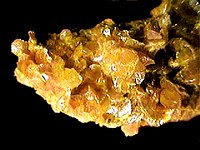
Photo from wikipedia
The inexorable increase of energy demand and the efficiency bottleneck of monocrystalline silicon solar cell technology is promoting the research and development of alternative photovoltaic materials. Copper-arsenic-sulfide (CAS) compounds are… Click to show full abstract
The inexorable increase of energy demand and the efficiency bottleneck of monocrystalline silicon solar cell technology is promoting the research and development of alternative photovoltaic materials. Copper-arsenic-sulfide (CAS) compounds are still rather unexplored in the literature, yet they have been regarded as promising candidates for use as p-type absorber in solar cells, owing to their broad raw material availability, suitable bandgap and high absorption coefficient. Here, a comprehensive study is presented on the structural and optoelectronic properties of CAS thin-films deposited via radio-frequency magnetron co-sputtering, using a commercial Cu target together with a Cu-As-S target with material obtained from local resources, specifically from mines in the Portuguese region of the Iberian Pyrite Belt. Raman and X-ray diffraction analysis confirm that the use of two targets results in films with pronounced stoichiometry gradients, suggesting a transition from amorphous CAS compounds to crystalline djurleite (Cu31S16), with the increasing proximity to the Cu target. Resistivity values from 4.7 mΩ·cm to 17.4 Ω·cm are obtained, being the lowest resistive films, those with pronounced sub-bandgap free-carrier absorption. The bandgap values range from 2.20 to 2.65 eV, indicating promising application as wide-bandgap semiconductors in third-generation (e.g., multi-junction) photovoltaic devices.
Journal Title: Nanomaterials
Year Published: 2022
Link to full text (if available)
Share on Social Media: Sign Up to like & get
recommendations!